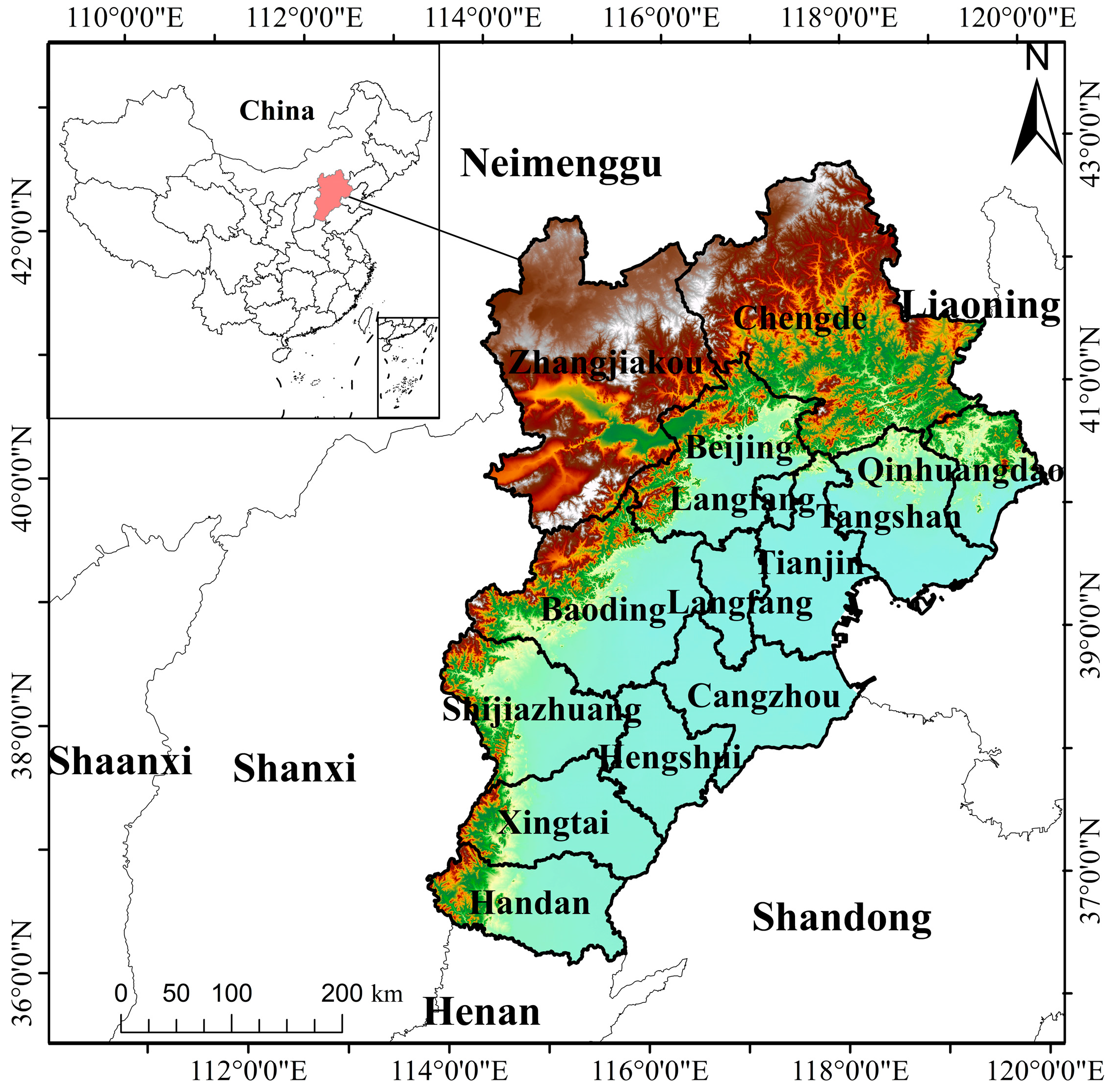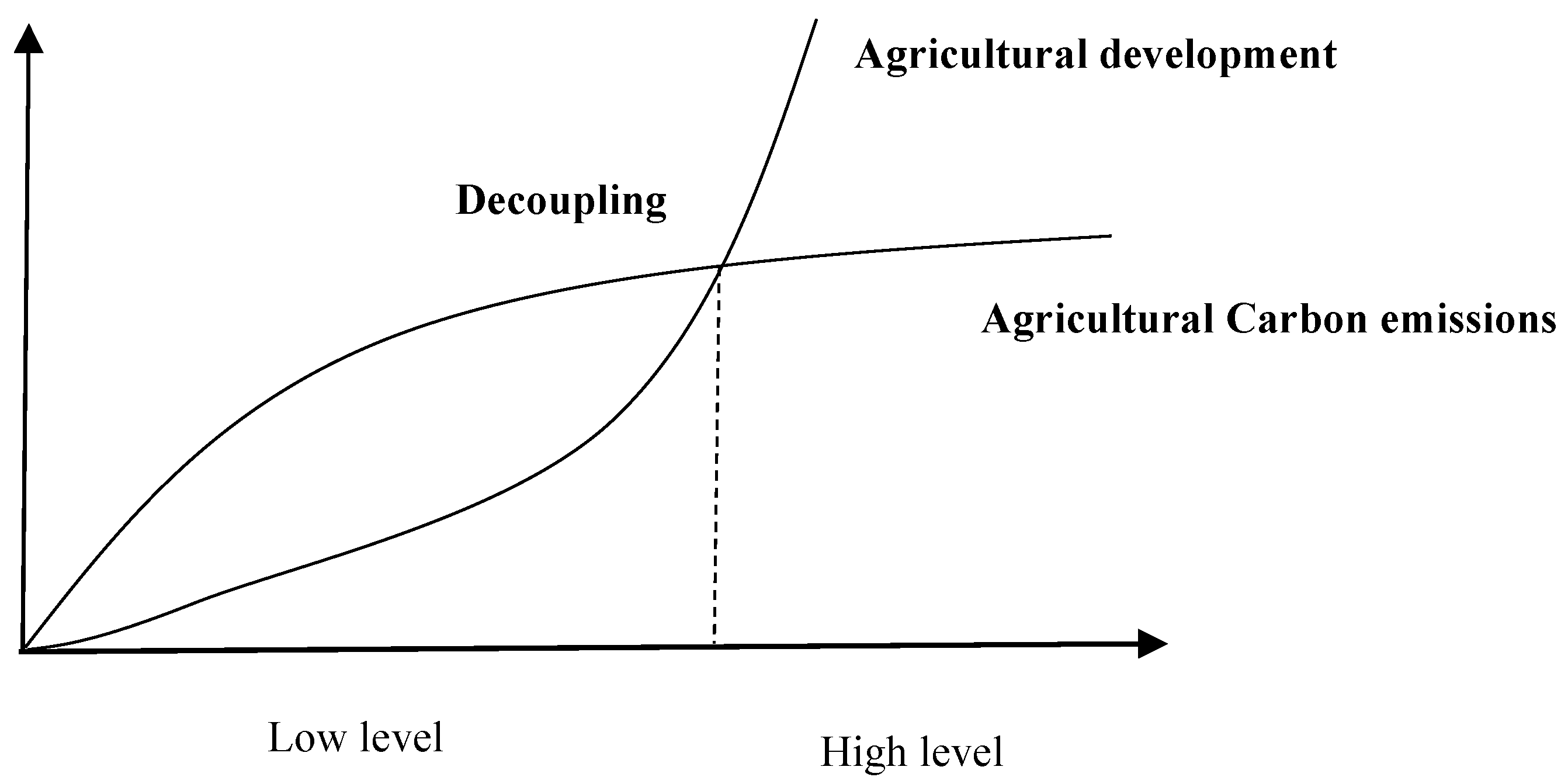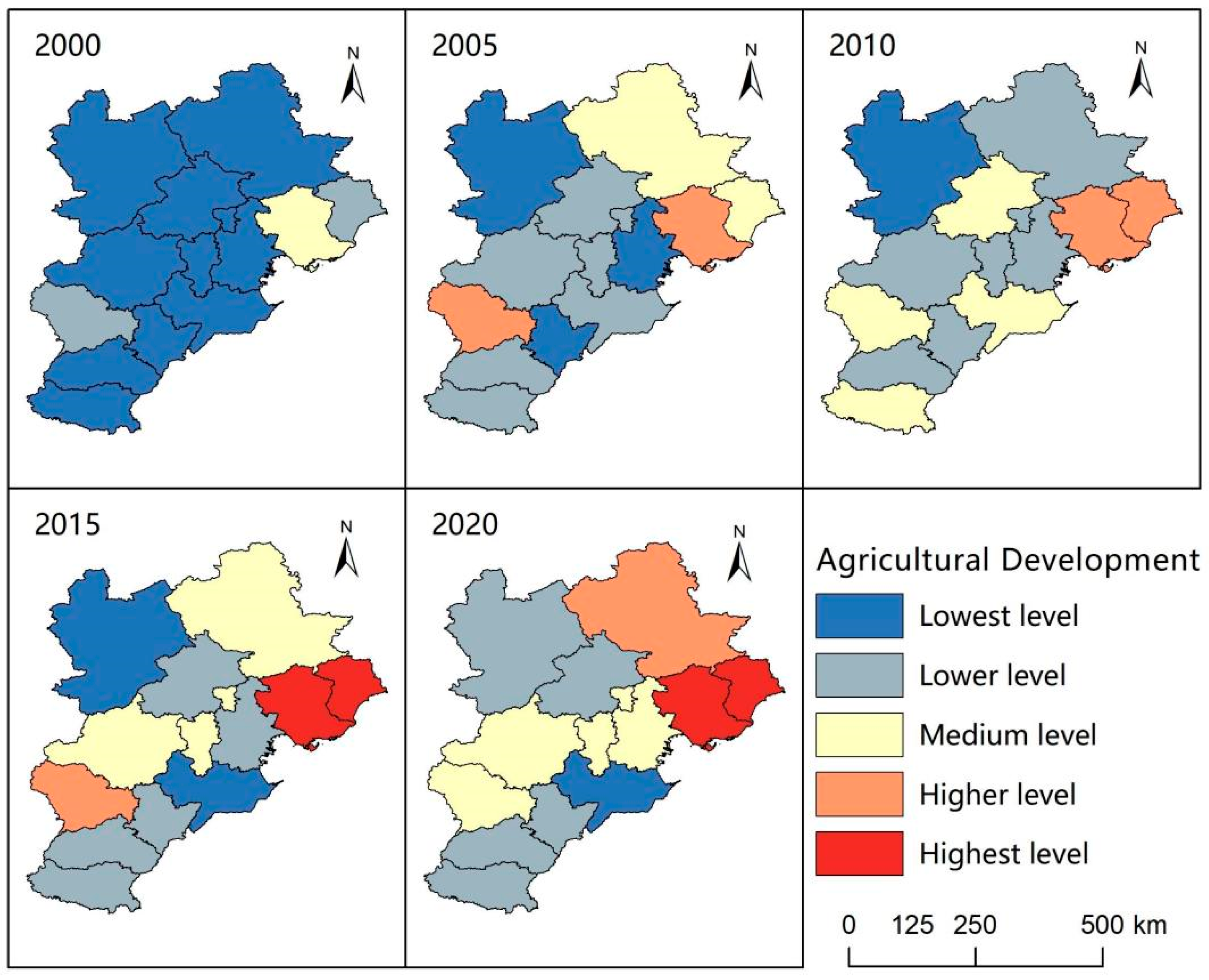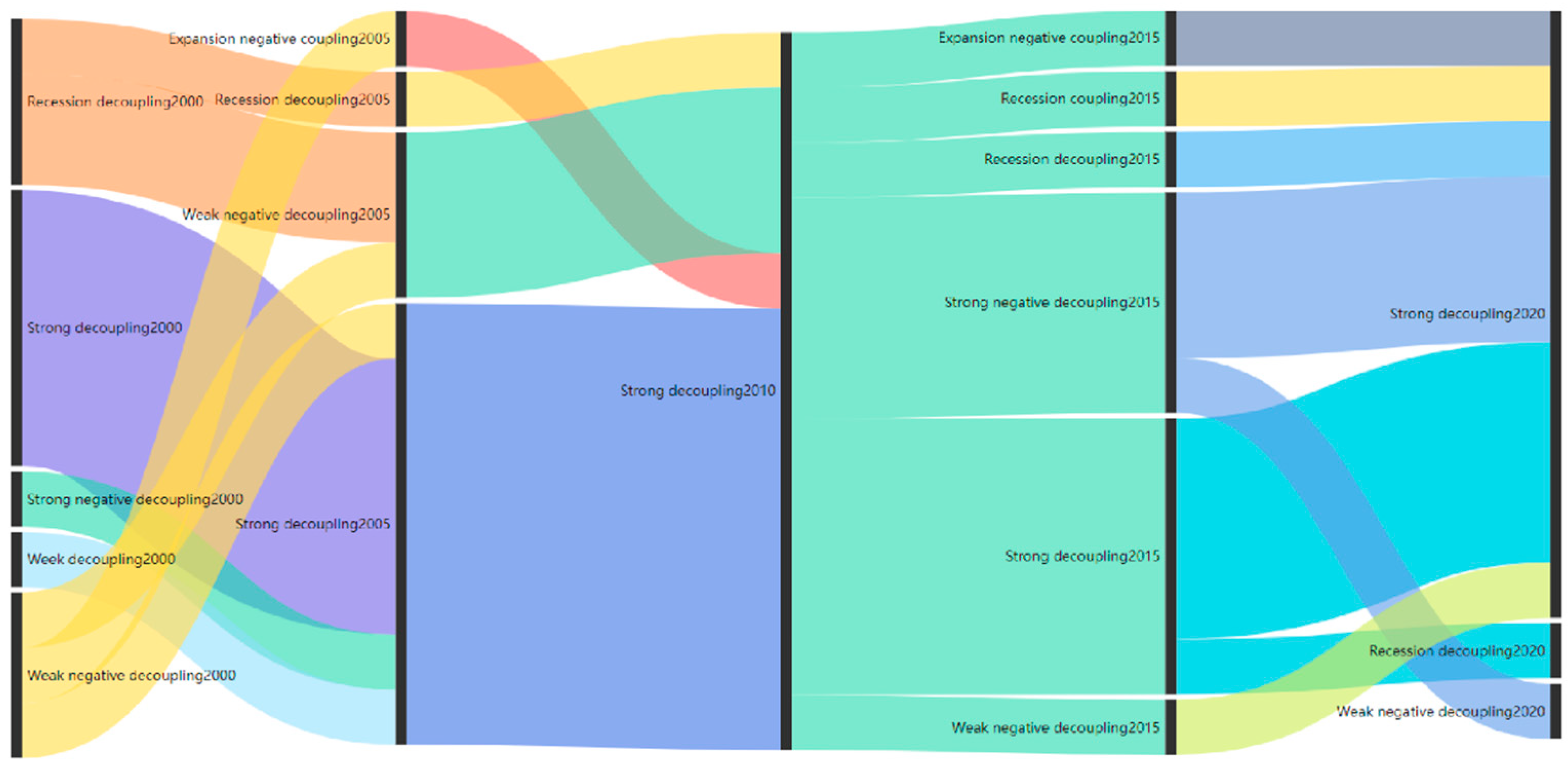Study of the Decoupling Patterns between Agricultural Development and Agricultural Carbon Emissions in Beijing Tianjin Hebei Region from 2000 to 2020
Abstract
:1. Introduction
2. Literature Review
3. Study Area and Research Methods
3.1. Study Site
3.2. Data Sources
3.3. Research Framework and Methods
3.3.1. Agricultural Development Evaluation
3.3.2. Agricultural Carbon Emissions Evaluation
3.3.3. Decoupling Model
4. Results and Analysis
4.1. Agricultural Development Evaluation
4.2. Agricultural Carbon Emissions
4.3. Decoupling of Agricultural Development and Agricultural Carbon Emissions Intensity
5. Discussion and Conclusions
5.1. Discussion
5.2. Conclusions
Author Contributions
Funding
Data Availability Statement
Conflicts of Interest
References
- Fang, J.Y.; Zhu, J.L.; Wang, S.P.; Yue, C.; Shen, H.H. Global warming, human-induced carbon emissions, and their uncertainties. Sci. China Earth Sci. 2011, 54, 11. [Google Scholar] [CrossRef]
- Zhang, J.B.; He, K. Research on low-carbon development of agriculture under the “dual carbon” goal: Current situation, misconceptions, and prospects. Agric. Econ. Issues 2022, 513, 12. [Google Scholar]
- Cai, B.F.; Zhu, S.L.; Yu, S.M.; Dong, H.M.; Zhang, C.Y.; Wang, C.K. Interpretation of ‘IPCC 2006 National Greenhouse Gas Inventories Guidelines 2019 Revision’. Environ. Eng. 2019, 37, 11. [Google Scholar]
- Tian, S.; Wang, S.; Bai, X.; Luo, G.; Li, Q.; Yang, Y. Global patterns and changes of carbon emissions from land use during 1992–2015. Environ. Sci. Ecotechnol. 2021, 7, 100108. [Google Scholar] [CrossRef] [PubMed]
- Li, S.L.; Wang, Z.Z. The Effects of Agricultural Technology Progress on Agricultural Carbon Emission and Carbon Sink in China. Agriculture 2023, 13, 793. [Google Scholar] [CrossRef]
- Grossman, G.M.; Krueger, A.B. Environmental impacts of a north American free trade agreement. CEPR Discuss. Pap. 1992, 8, 223–250. [Google Scholar]
- Vleeshouwers, L.M.; Verhagen, A. Carbon emission and sequestration by agricultural land use: A model study for Europe. Glob. Chang. Biol. 2010, 8, 519–530. [Google Scholar] [CrossRef]
- Johnson, M.F.; Franzluebbers, A.J.; Weyers, S.L.; Reicosky, D.C. Agricultural opportunities to mitigate greenhouse gas emissions. Environ. Pollut. 2007, 150, 107–124. [Google Scholar] [CrossRef]
- Li, K.; Zhang, H.; Shi, L. An empirical test of the spatial spillover effect of agricultural scientific and technological progress on agricultural carbon emissions. Stat. Decis. Mak. 2023, 39, 52–57. [Google Scholar]
- Mohanad, I.; Fathi, S.; Amine, M.B. Agricultural technologies and carbon emissions: Evidence from Jordanian economy. Environ. Sci. Pollut. Res. Int. 2018, 25, 10867–10877. [Google Scholar]
- Arun, K.C.; Tek, B.S.; Sofina, M.; Noufa, C.K.; Paresh, S. Agricultural emissions reduction potential by improving technical efficiency in crop production. Agric. Syst. 2023, 207, 103620. [Google Scholar]
- Wang, M.; Feng, C. Decoupling economic growth from carbon dioxide emissions in China’s metal industrial sectors: A technological and efficiency perspective. Sci. Total Environ. 2019, 691, 1173–1181. [Google Scholar] [CrossRef] [PubMed]
- Yang, Q.L.; Zhao, R.Q.; Hu, Y.M.; Xiao, L.G.; Xie, Z.X.; Chuai, X.W.; Xie, Y.K. The spatio-temporal coupling relationship between economic and social factors and carbon emission in Beijing-Tianjin-Hebei region. J. Ecol. 2023, 43, 3458–3472. [Google Scholar]
- Mosier, A.R.; Duxbury, J.M.; Freney, J.R.; Heinemeyer, O.; Minami, K.; Johnson, D.E. Mitigating agricultural emissions of methane. Clim. Chang. 1998, 40, 39–80. [Google Scholar] [CrossRef]
- He, H.S.; Fu, B.J. Research on agricultural carbon emission measurement and emission reduction pressure in major grain producing areas in China. Eco-Economy 2019, 35, 99–104. [Google Scholar]
- Fan, Z.Y.; Qi, X.B.; Zeng, L.L.; Wu, F. Accounting of greenhouse gas emissions in China’s agricultural system in the past 40 years. Chin. J. Ecol. 2022, 42, 9470–9482. [Google Scholar]
- Yin, M.H.; Tian YLu, Y.H. Regional differences and spatial differentiation mechanism of agricultural carbon emissions in China. Reform 2023, 10, 130–145. [Google Scholar]
- Monchuk, D.C.; Chen, Z.; Bonaparte, Y. Explaining production inefficiency in China’s agriculture using data envelopment analysis and semi-parametric bootstrapping. Soc. Sci. Electron. Publ. 2010, 21, 346–354. [Google Scholar] [CrossRef]
- Zhang, L.; Pang, J.; Chen, X.; Lu, Z. Carbon emissions, energy consumption and economic growth: Evidence from the agricultural sector of China’s main grain-producing areas. Sci. Total Environ. 2019, 665, 1017–1025. [Google Scholar] [CrossRef]
- Ahmed, K.M.; Noshaba, A.; Tan, Z.X.; Yang, S.X.; Kashif, R.A.; Kong, R. Green growth of cereal food production under the constraints of agricultural carbon emissions: A new insights from ARDL and VECM models. Sustain. Energy Technol. Assess. 2021, 47, 101452. [Google Scholar]
- Dumont, B.; Ryschawy, J.; Duru, M.; Benoit, M.; Chatellier, V.; Delaby, L. Review: Associations among goods, impacts and ecosystem services provided by livestock farming. Anim. Int. J. Anim. Biosci. 2019, 13, 1773–1784. [Google Scholar] [CrossRef] [PubMed]
- René, V.; Stehfest, E.; Woltjer, G.; Eickhout, B. The effect of agricultural trade liberalization on land-use related greenhouse gas emissions. Glob. Environ. Chang. 2009, 19, 434–446. [Google Scholar]
- Balogh, J.M. The impacts of agricultural subsidies of Common Agricultural Policy on agricultural emissions: The case of the European Union. Agric. Econ. 2023, 69, 140–150. [Google Scholar] [CrossRef]
- Fortune, G. The influence of agricultural policy on carbon emissions in selected OECD countries. Heliyon 2023, 9, e19881. [Google Scholar]
- Baumann, M.; Gasparri, I.; María, P.R.; Pizarro, G.G.; Griffiths, P.; Hostert, P. Carbon emissions from agricultural expansion and intensification in the chaco. Glob. Chang. Biol. 2017, 23, 1092–1916. [Google Scholar] [CrossRef] [PubMed]
- Jaroslaw, J.; Ela, E. Impact of land consolidation on agricultural decarbonization: Estimation of changes in carbon dioxide emissions due to farm transport. Sci. Total Environ. 2023, 873, 162391. [Google Scholar]
- He, Y.Q.; Dai, X.W. Spatial and temporal characteristics of driving factors of agricultural carbon emissions in China. Resour. Sci. 2016, 38, 1780–1790. [Google Scholar]
- Zhao, Y. Analysis of influencing factors and prediction of trend of agricultural carbon emission in Jiangsu province. Agric. Resour. Reg. China 2018, 39, 97–102. [Google Scholar]
- Bai, F.C.; Gao, P.; Zheng, W.L. Spatio-temporal evolution and decoupling effect of farmland ecosystem carbon footprint in major grain-producing areas. Eco-Economy 2023, 39, 107–116. [Google Scholar]
- Xu, Y.; Wang, H.; Han, Q.F. Spatio-temporal characteristics of agricultural carbon emissions in Xuzhou and decoupling effects. Circ. Soil Water Conserv. 2023, 43, 395–403. [Google Scholar]
- Tian, Y.; Lin, Z.J. The coupling and coordination between agricultural carbon emission efficiency and economic growth in China’s provinces. Popul. Resour. Environ. China 2022, 32, 13–22. [Google Scholar]
- Yu, Z.H.; Mao, S.P. Analysis of the decoupling of China’s agricultural net carbon emissions from its economic growth. Popul. Resour. Environ. China 2022, 32, 30–42. [Google Scholar]
- FAO. The State of Food and Agriculture 2016: Climate Change, Agriculture and Food Security; United Nations: New York, NY, USA, 2016. [Google Scholar]
- Min, J.S.; Hu, H. Estimation of greenhouse gas emissions from agricultural production in China. Popul. Resour. Environ. China 2012, 22, 21–27. [Google Scholar]
- Xie, T.; Zhang, H.; Miao, J.; Song, M.W.; Zeng, Y.Q. Emission characteristics and source/sink analysis of greenhouse gases from farmland ecosystem in Hubei province. J. Agric. Resour. Environ. 2021, 38, 839–848. [Google Scholar]
- Ning, J.; Yang, N.; Du, G.M.; Sun, T.C.; Hu, M.J.; Wang, L. A Study on the Temporal and Spatial Evolution of Carbon Footprint in Regional Farmland Ecosystems: A Case Study of Heilongjiang Province. J. China Agric. Univ. 2023, 28, 98–112. [Google Scholar]
- Xu, W.H.; Xie, Y.L.; Xia, D.H.; Ji, L.; Huang, G.H. A multi-sectoral decomposition and decoupling analysis of carbon emissions in Guangdong province, China. J. Environ. Manag. 2021, 298, 113485. [Google Scholar] [CrossRef]
- Raza, M.Y.; Lin, B. Decoupling and mitigation potential analysis of CO2 emissions from pakistan’s transport sector. Sci. Total Environ. 2020, 730, 139000. [Google Scholar] [CrossRef]
- Xie, P.; Gao, S.; Sun, F. An analysis of the decoupling relationship between CO2 emission in power industry and GDP in China based on lmdi method. J. Clean. Prod. 2019, 211, 598–606. [Google Scholar] [CrossRef]
- Tapio, P. Towards a theory of decoupling: Degrees of decoupling in the EU and the case of road traffic in Finland between 1970 and 2001. Transp. Policy 2005, 12, 137–151. [Google Scholar] [CrossRef]








| Agricultural Development | Index | Calculational Method | Weight |
|---|---|---|---|
| Per capita agricultural output value | Per capita output value of agriculture, forestry, animal husbandry and fishery | Total output value of agriculture, forestry, animal husbandry and fishery/Total Agricultural Population | 0.35 |
| Average agricultural output value per land | Gross agricultural output per capita | Total agricultural output value/Total area of agricultural land | 0.30 |
| Farmer income level | Net income of the primary industry per capita | Net income of the primary industry/Total Agricultural Population | 0.25 |
| Growth in agricultural output value | Growth rate of total output value of agriculture, forestry, animal husbandry and fishery | Increase in total output value of agriculture, forestry, animal husbandry, and fishery/Total output value of agriculture, forestry, animal husbandry and fishery in the previous year | 0.10 |
| Carbon Source | Carbon Emission Factor | Carbon Source | Carbon Emission Factor | ||
|---|---|---|---|---|---|
| Agricultural land use | Nitrogenous fertilizer | 2.10 kg/kg | Livestock and poultry farming | Milk cow | 653.93 kg/head |
| Phosphate fertilizer | 0.64 kg/kg | Yellow cow | 445.92 kg/head | ||
| Potash fertilizer | 0.18 kg/kg | Buffalo | 497.49 kg/head | ||
| Compound fertilizer | 1.77 kg/kg | Sheep | 61.99 kg/head | ||
| Pesticide | 4.93 kg/kg | Pig | 43.48 kg/head | ||
| Plastic sheeting | 5.18 kg/kg | Horse | 246.85 kg/head | ||
| Agricultural machinery diesel | 0.59 kg/kg | Donkey | 187.27 kg/head | ||
| Agricultural irrigation | 266.48 kg/km2 | Mule | 187.27 kg/head | ||
| Ploughing | 312.60 kg/hm2 | Camel | 439.65 kg/head | ||
| Rice | Rice | 1045.12 kg/hm2 | Rabbit | 3.9 kg/head | |
| Fowl | 1.76 kg/head | ||||
| Decoupling State | ∆AG | ∆ACEI | Tn+1 | Decoupling State | Code |
|---|---|---|---|---|---|
| Strong Decoupling | >0 | <0 | <0 | AD increase and ACEI decrease | SD |
| Recession decoupling | <0 | <0 | >1.2 | The decline rate of AD is greater than the increase rate of ACEI | RD |
| Recession coupling | <0 | <0 | 0.8 < T < 1.2 | AD and ACEI synchronous reduction | RC |
| Weak negative decoupling | <0 | <0 | 0 < T < 0.8 | AD reduction speed is smaller than ACEI | WND |
| Strong negative decoupling | <0 | >0 | <0 | AD decrease and ACEI increase | SND |
| Expansion negative coupling | >0 | >0 | >1.2 | The speed of AD increase is smaller than ACEI | ENC |
| Expansion coupling | >0 | >0 | 0.8 < T < 1.2 | AD and ACEI synchronized improvement | EC |
| Weak Decoupling | >0 | >0 | 0 < T < 0.8 | AD increase speed is higher than ACEI | WD |
| Year | Beijing | Tianjin | Baoding | Tangshan | Shijiazhuang | Langfang | Qinhuangao | Zhangjiakou | Chengde | Cangzhou | Hengshui | Xingtai | Handan |
|---|---|---|---|---|---|---|---|---|---|---|---|---|---|
| 2000–2001 | WD | WND | SD | D | SD | SD | SD | SND | SD | RD | RD | RD | WND |
| 2001–2002 | WD | SND | SD | WD | ENC | SND | RD | SD | WND | WND | SD | SD | SD |
| 2002–2003 | ENC | SD | SND | WD | SD | SD | SND | WND | SD | SD | SD | SD | SND |
| 2003–2004 | SD | SND | SD | SD | SD | SND | SD | SD | SD | SD | SND | SD | SD |
| 2004–2005 | SD | SD | SD | ENC | SD | SD | SD | SD | SD | WND | WND | RD | WND |
| 2005–2006 | SD | SD | SD | SD | SD | SD | SD | SD | SD | SD | SD | SD | SD |
| 2006–2007 | SD | SD | SD | SD | RD | SND | SD | WND | SD | SD | SD | SD | SD |
| 2007–2008 | SD | WD | EC | SD | SD | WND | SD | RD | SD | SD | SD | RD | WND |
| 2008–2009 | SD | SD | SD | SD | SND | SD | SD | WND | WND | RD | RD | WD | SD |
| 2009–2010 | SD | SD | SD | SD | SD | SD | SD | SD | SD | SD | SD | SD | SD |
| 2010–2011 | SD | SD | SD | SD | SD | SD | SD | WND | SD | SD | SD | SD | WND |
| 2011–2012 | SD | SD | SD | ENC | SD | SD | SD | SD | SD | RD | SD | WND | SD |
| 2012–2013 | SD | SD | SD | SD | SD | WD | SD | SD | SD | SND | RD | SND | RD |
| 2013–2014 | WND | SD | SD | SD | SND | WND | RD | WD | SD | RD | SD | SD | SND |
| 2014–2015 | RC | SD | ENC | SD | SND | SD | RD | SND | SND | SD | SND | WND | SD |
| 2015–2016 | SND | SND | SD | SD | SND | WND | SD | RC | RD | WND | WND | SND | SD |
| 2016–2017 | SD | RD | SD | SND | SD | WD | RD | WND | SD | SD | WD | SND | SD |
| 2017–2018 | WND | SD | SND | SD | SD | SND | SD | ENC | SD | SD | RD | SD | WND |
| 2018–2019 | SND | SD | SD | SD | SD | SD | SD | SD | SD | WND | SD | RD | SND |
| 2019–2020 | SD | SD | SD | SD | WND | RD | SD | SD | SD | SD | SD | SD | SD |
Disclaimer/Publisher’s Note: The statements, opinions and data contained in all publications are solely those of the individual author(s) and contributor(s) and not of MDPI and/or the editor(s). MDPI and/or the editor(s) disclaim responsibility for any injury to people or property resulting from any ideas, methods, instructions or products referred to in the content. |
© 2024 by the authors. Licensee MDPI, Basel, Switzerland. This article is an open access article distributed under the terms and conditions of the Creative Commons Attribution (CC BY) license (https://creativecommons.org/licenses/by/4.0/).
Share and Cite
Liang, L.; Wang, H.; Huai, H.; Tang, X. Study of the Decoupling Patterns between Agricultural Development and Agricultural Carbon Emissions in Beijing Tianjin Hebei Region from 2000 to 2020. Land 2024, 13, 839. https://doi.org/10.3390/land13060839
Liang L, Wang H, Huai H, Tang X. Study of the Decoupling Patterns between Agricultural Development and Agricultural Carbon Emissions in Beijing Tianjin Hebei Region from 2000 to 2020. Land. 2024; 13(6):839. https://doi.org/10.3390/land13060839
Chicago/Turabian StyleLiang, Lina, Hongjia Wang, Heju Huai, and Xiumei Tang. 2024. "Study of the Decoupling Patterns between Agricultural Development and Agricultural Carbon Emissions in Beijing Tianjin Hebei Region from 2000 to 2020" Land 13, no. 6: 839. https://doi.org/10.3390/land13060839





